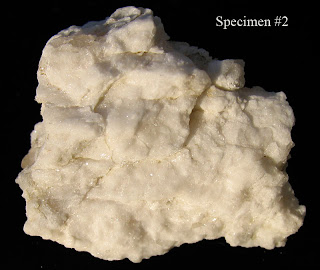A December 19, 2010 posting on this blog highlighted a mineral specimen that had grown out of Devonian period brachiopod fossil. The question this fossil produced, was what mineral was it? After researching minerals found in the county of that fossil, it appeared to be either gypsum or aragonite. Thanks to blog reader Howard of Calgary, Canada, who provided a chemical test for helping decide which.
As part of the test I included two other specimens taken from Mississippian period road cuts about 25 miles south of Louisville, Kentucky. I suspected both could be gypsum as well.
Small samples of three specimens were placed on a glass plate. Diluted hydrochloric acid was then dripped on each sample until immersed. The plate was then left for the liquid to evaporate. The plate was then examined under 100x magnification using a microscope.
The first specimen had quite a bit of limestone in it. The acid began fizzing right away once in contact. It does not appear to be gypsum. The first image is interesting it that gray beads appeared on part of the slide.
Specimen #2 ended up being the most visually appealing under the microscope. It is gypsum seeing the crystal balls that formed around the perimeter of where the acid evaporated on the glass slide.
As for the fossil, after looking at its glass plate the mineral appears to be aragonite. The sample fizzed when exposed to acid but no crystal ball formation after evaporation.
My blog posting has been sporadic as of late. A bad case of the flu really disrupted my work flow which I still have not recovered from.













No comments:
Post a Comment